![]() ECONOMY
ECONOMY
![]()
Within the 357 Kmē commune's surface, 242,4 kmē are farmland. The permanent or seasonal cultures take 56,43 Kmē, the natural or artificial pastures totalize 130,68 Kmē and the natural or cultived woods 37,27Kmē. 10,37 Kmē of the land are fallowlands (Graphic below).
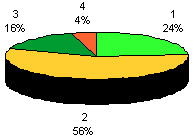
1. Cultures - 2. Pastures - 3. Woods - 4. Fallows
5.669 peoples work on the farming sector : 3.721 men and 1.948 women (Graphic below).
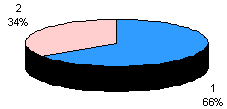
1. Men - 2. Women
The farming produces an annual income of about 28.272.000 Reais to the commune. The most important part of this income is got by the vegetables production (Graphic below).
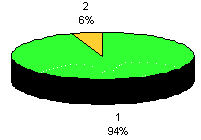
Farming ratio: 1. Vegetables - 2. Cattle breading
That's a fondamental data to understand the performance and the productivity of the commune. When we see that 56 % of the farming surface of Sumidouro is taken by pastures and its annual income is about 1.606.000 Reais (1.500.000.000 US$), we can conclude that the catlle-breeding sector is extremely unperforming. Another interesting data is the ratio of the number of farmlands and its height. In the graphic below we can see that the most of the farms have less than 10 hectars. It explains, partialy, the low mecanisation level of the farming (only 136 tractors). Otherwise this data is very interesting because it shows an equitable sharing of the land.
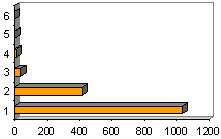
Number of farms according to their height :
1. <10 ha (1.039) - 2. 10-100 ha (421)- 3. 100-200 ha (37) - 4. 200-500 ha (8) -
5. 500-2.000 ha (2) - >2.000 ha (0)
Nevertheless, the positive side of the land distribution is misleading, because there is a high number of parteners (540), lodgers (116) and occupiers (34) compared to the number of owners(817). The graphic below shows this proportion comparing which category with the land's heigth used.
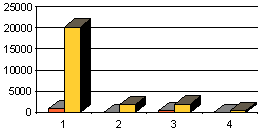
Farmer's kind ratio compared to the heigth of their farms:
1. Owners (20.153 ha) - 2. Lodgers (1.740 ha) - 3. Parteners (1.951 ha)- 4. Occupiers (392 ha)
Another problem that caracterises the Sumidouro's agriculture is the carefree attitude of its farmers about the management of the environement. The soil erosion is a big problem but the farmers are blind. The peruvian indians manage better the soil erosion than the Sumidouro's farmers. They just do'nt want heard about simple and cheap solutions like terraces. You can know more about it clicking NATURE.
